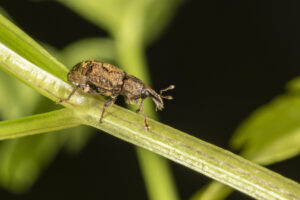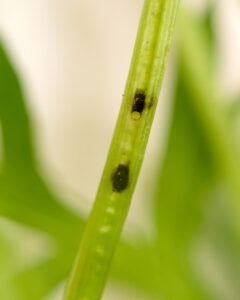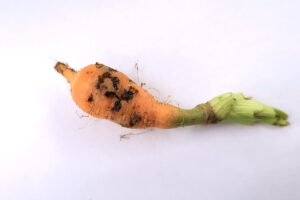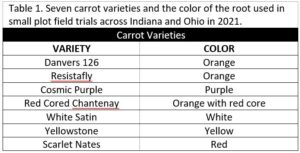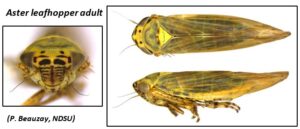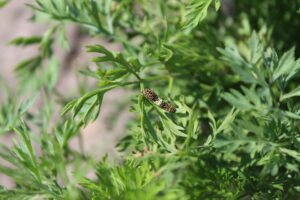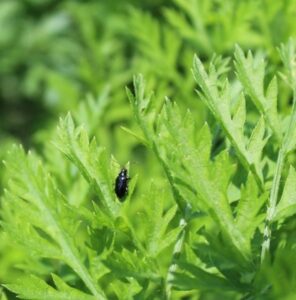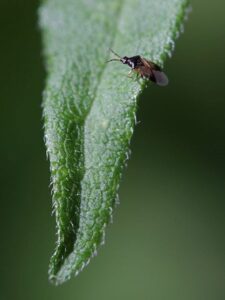Carrots are a wonderfully diverse crop with a wide array of varieties available to growers. Within this diversity lies the potential for identifying varieties that have higher natural resistance to particular kinds of insect pests. Although it is not a major pest in Indiana, the carrot weevil (Listronotus oregonensis) (Figure 1A) is a serious pest of carrots, parsley, and celery that the Long Lab has been researching for several years. Growers of these crops in the Great Lakes and Mid-Atlantic regions of North America struggle to manage the carrot weevil using insecticides alone, so we wanted to explore if different crop varieties might have natural resistance to this beetle. Carrot weevils lay eggs in the stem or crown of plants (Figure 1B), and when larvae hatch, they tunnel throughout the root, killing young plants and making carrots and celery unmarketable (Figure 2). Exploring whether insect communities differ on certain crop varieties and if these varieties differ in their susceptibility to damage from plant-feeding insects could help inform decisions to use resistant crop varieties as part of a pest management plan.
During May-August 2021, we used a D-Vac suction sampler (Figure 3)to evaluate insect communities on seven varieties of carrots (Table 1) planted in small field plots in Demotte and Lafayette, Indiana, where the carrot weevil is less prevalent, and Willard, Ohio, where the carrot weevil is a key pest. We aimed to learn if 1) carrot weevil damage differed across carrot varieties, and 2) the abundance and diversity of pest and beneficial (predatory) insects differed throughout the season among carrot varieties at each location.

Figure 3. Zach Serber, a Master’s student in the Long Lab, operating a D-vac insect suction sampler at Meigs Purdue Agriculture Center. Photo by Emily Justus.
We sampled insects in carrot plots four times during the season, counted carrot weevil egg scars (Figure 1), and on our final sampling date we harvested carrots and measured yield, as well as severity of tunneling root damage by carrot weevil larvae.
Carrot weevil activity: Carrot weevil egg scars and tunneling damage were found at all three locations this summer. Interestingly, Cosmic Purple was the only carrot variety that had tunneling damage at all three sites.
Plant-feeding insects found on carrots: One of the most common insect groups we collected from carrots were leafhoppers. These piercing-sucking insects damage plants by feeding on the phloem. One particular leafhopper of interest that we found is the aster leafhopper (Macrosteles quadrilineatus) (Figure 4) which is considered a significant pest because it acts as a vector of aster yellows disease (Candidatus spp.). Aster yellows phytoplasma commonly causes yellowing (chlorosis) and stunting, leading to yield and quality loss in many different crops. Carrots that are infected with aster yellows may also develop denser root hairs (unsightly to consumers) and can have a bitter taste.
The most charismatic plant-feeding insect we spotted in carrot plots this season were Eastern black swallowtail (Papilio polyxenes asterius) caterpillars. These caterpillars camouflage themselves as bird poop when they are young (Figure 5), but as they grow, they develop into large green, black, white, and yellow caterpillars. These caterpillars are not typically pests in carrot, parsley, or celery cropping systems. We also found other chewing insects in our carrots, including the red-headed flea beetle (Systena frontalis) (Figure 6) and several kinds of grasshoppers.
Predatory insects found on carrots: Where there are prey there are often predators, and this season we found lady beetles, lacewing larvae, parasitoid wasps, and minute pirate bugs (Figure 7). These beneficial insects seek out and feed on a variety of life stages of other soft-bodied pest insects, including eggs, nymphs, and caterpillars.
We will continue counting and identifying the insects we collected from our carrot plots over the summer to see if differences exist in the number and type of insects on each carrot variety throughout the season, and whether a relationship exists between pest insects and carrot damage/yield. We hope this information will provide us with a better understanding of the relationship between crop variety and the potential for pest insect damage.
